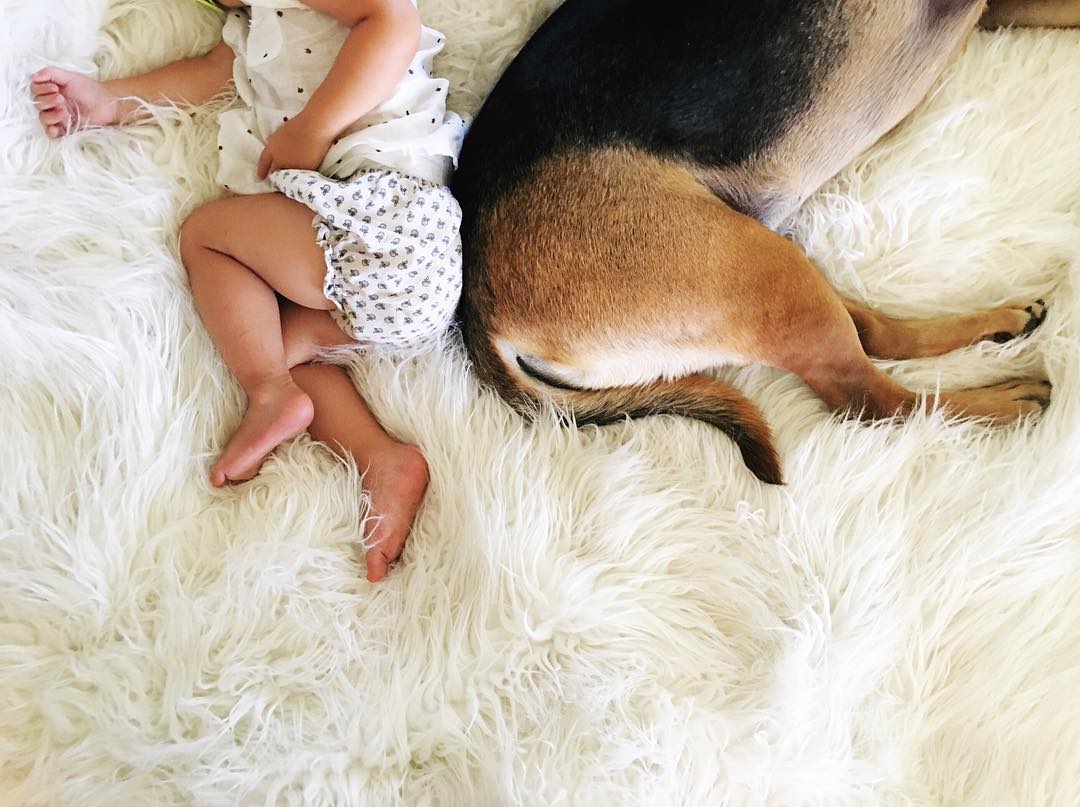Let’s be honest. When a couple says “We’re getting a dog!” we all know what they actually mean is, “Things are getting pretty serious, so this is a baby test run.”
I’m not a mom yet, but I’ve often thought about my own puppy and baby timeline. Do I get a puppy first and acclimate to the responsibility before having kids? Or do I get — I mean, have — a baby first and get a puppy later when the baby is old enough to help walk it? Yes, these are the things I think about. (Side note: Please don’t tell my boyfriend I wrote this.)
If you do go the dog before baby route, you’ll want to adequately prepare your pup for his new human sibling to ensure a smooth transition and peaceful relationship. I spoke to Emily Cohen-Moreira, founder of Lucy the Laborer and Certified Labor Support Doula, about tricks for prepping your pup for a new baby in the house. What can I say? I like to plan ahead.
Before bringing your baby back from the hospital, bring home swaddle blankets for your dog to smell.
You can put blankets or baby hats in your dog’s bed to familiarize him with the scent before the baby actually comes home.
Consider your dog’s sleeping routine.
“Dog owners that have the dog sleeping in the bed with them don’t always think about boundaries that they need to create before the baby is born,” Emily explains. Babies are supposed to sleep in their parents’ room for the first six to twelve months, so if the baby is in the bed, the dog definitely shouldn’t be. “That’s a challenge I’ve seen some of my clients have.”
If you’re having a home birth, come up with a plan for your what your pup will be doing during labor.
“Whenever I have clients having home births, I always ask, ‘What’s the plan for the pets?’ Some dogs are great and kind of hang out in the corner, while other are more high-need or anxious. I once had a home birth with a family who had never had any kind of boundaries with their dog, and the poor dog was really freaking out.” Home births involve a lot of excitement (and sterile equipment), so if your dog is sticking around, make sure he isn’t prone to jumping on the bed.
Snuggle with your dog during labor – it’s biologically good for you.
This one is also specific to home births. “Snuggling with your dog gives you an oxytocin rush, which is great for encouraging labor progress and tends to be really soothing and comforting.” If this is a route you see yourself taking, make sure your dog acclimates to your midwife before labor. “You don’t want the dog to start freaking out or become overprotective.”
Incorporate your dog into new, daily routines with the baby.
“For my clients who breastfeed, I always recommend that they pet or talk to the dog while they’re sitting there. When you’re taking the baby out for a walk, try to bring the dog. Learn to use a baby carrier so that you can walk the dog at the same time. Sometimes people will try to keep the dog out of the baby’s room in order to differentiate space, but you also don’t want to create an environment where the dog feels left out or punished.”
It might not be your instinct to prioritize the dog when you have a screaming baby – and that’s okay.
When you’ve just had a baby, every instinct in your body is telling you to focus on nothing else but that tiny human. It’s not easy to admit, but in those early days, even your beloved dog can feel like an annoyance. “If you try to make a really conscious effort to involve the dog in all of your routines and activities, it becomes a lot smoother for everybody,” Emily advises.
Be aware of potential toy mixups.
“Even though my dog was disruptive with his own toys, he learned very quickly how to differentiate between his stuff and the baby’s.” I was surprised by how little effort it took for him to realize, okay, this is her stuffed animal, so I’m not going to rip it apart. I didn’t feel like I had to punish him or yell at him about it.”
Your dog might surprise you, too, but it’s still always a good idea to keep any potentially unsafe toys out of reach for both baby and dog.
Age matters.
Unless you hate sleep, it’s probably not the best idea to get a new puppy the same week you go into labor.
“Most pets do great with babies, but I think it can also depend on the age of the dog,” Emily shares.
Still, having a baby and dog somewhat close in age can make for some incredible shared milestones.
“My dog was two when we had our baby, so we were definitely thinking about them having a life together. It becomes a really nice thing. As my daughter got older, her “job” was feeding the dog and giving the dog cookies. It was a very fun way to give her those first little tasks around the house. They’re so cute together.”
Emily Cohen-Moreira is a Certified Cooperative Childbirth Educator, Certified Lactation Counselor, and Labor Support Doula. She is the founder of Lucy the Laborer, an organization that provides multilingual pregnancy, birth, and lactation education and services in the greater New York City area.
Image: @mommasgonecity









